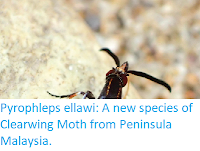Tropical Burnet Moths, Lacturidae, are found in tropical and subtropical areas across the world, with their maximum diversity in the Indo-Australian regions. They are small-to-medium sized Moths with wingspans of 11-65 mm, and tend to be cream in colour with orange, red and yellow patterns. Their larvae are leaf skeletonisers, and tend to be brightly coloured. Seventeen species are known from North and Central America, though all of these are rather similar in general appearance, with grey forewings with rows of red or black spots, and uniformly pink-red hindwings, and individuals being variable within this general pattern, making it difficult to identify these Moths to species level.
In a paper published in the journal ZooKeys on 23 October 2017, Tanner Matson and David Wagner of the Department of Ecology and Evolutionary Biology at the University of Connecticut, describe a new species of Tropical Burnet Moth from southern Texas.
The new species is placed in the genus Lactura and given the specific name rubritegula, meaning 'red tegula', where the tegula is the section of carapace above and before the wing of an Insect (roughly the 'shoulder'). The species is easily distinguished by this red area. The males of the species have wingspans of 9.5 to 10.5 mm, the females are slightly larger at 10.0-12.0 mm, but otherwise similar with salmon-red bodies and cream wings.
Lactura rubritegula, male specimen. Matson & Wagner (2017).
Larvae of this species are greenish with red stripes and yellow spots, and are found on the leaves of the Gum Bully bush, Sideroxylon lanuginosum, with flying adults observed in April and May and larvae taking a year to mature. The species was discovered in Hill County in southern Texas, and a single specimen was also found in Harris County, however the Gum Bully bush is widely distributed in the southern United States and Mexico, and it is possible that this Moth has a similar distribution and has previously been overlooked.
Larvae of Lactura rubritegula. Matson & Wagner (2017).
See also...
Follow Sciency Thoughts on Facebook.








